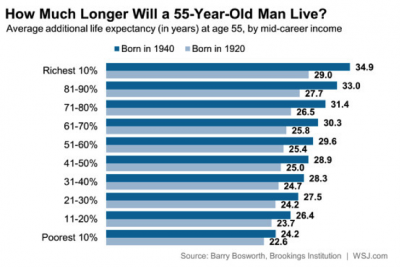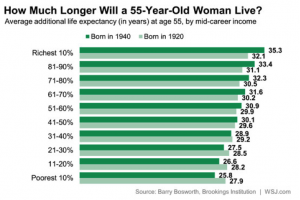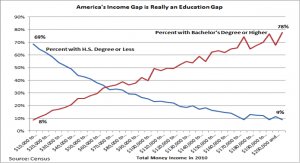The Life Expectancy Gap & Income
I have done a number of posts on the influence of income and eduction on life expectancy. This topic will get more and traction as discussion about raising the retirement age accelerates due to the demographic pressure on programs like Social Security and Medicare. If the retirement age is raised, the argument is that it will unfairly penalize people with lower incomes.
New Data on Income vs Life Expectancy
The graphics below are some new estimates by the Brookings Institution published in the Wall Street Journal that show the effects of income on life expectancy. The data show that better off people live longer and that this wealth effect is increasing for people born in 1940 vs. 1920. Life expectancy is actually getting worse for poor white women!
Education & Income
The graph below from the Tax Foundation shows that for the purposes of the sorts of population based comparisons I am making in this post, that education and income are essentially the same thing. This will become important as I try to factor out just how much of the life expectancy income/education gap is about money or perhaps other factors. If you use this graph and extrapolate the income and education data people without high school educations live 10 or more years less than those with bachelor’s degrees or higher. That is about what the life expectancy difference looks like when the top and bottom 10 or 20% of incomes are compared.
What About Sweden?
Sweden is a country that has done all it can to reduce and modulate the effects of social and economic inequality on its population. So are there life expectancy differences by income or education in Sweden? The graph below shows the data for a number of countries in Europe including Sweden. The individuals in top 25% of educational attainment (essentially college or more) are being compared to the individuals who did not finish high school. In Sweden the most educated men live about 4 years longer and the Women live about 3 years longer than their least educated counterparts. If you compare this to the differences between the top and bottom 10-20% of incomes in the US the differences are about 7 years for men and 8 for women. This number for men in the US is similar to the average value for OECD 14 countries but the gap for women in the U.S. is much higher.
The Persistent Gap
The point of all of this is that there is an income/education/life expectancy gap and even the social democracies of Northern Europe can’t make it go away. What is interesting is that like the US, smoking and other negative health behaviors are generally lower in well off and better educated people in this part of the world.
“The prevalence of smoking was higher in Denmark compared to Sweden. The total attributable fraction (TAF) of low education regarding daily smoking was 36% for Danish men and 35% for Danish women, and 32% and 46%, respectively, for Swedish men and women. TAF of low education regarding continued smoking were 16.2% and 15.8% for Danish men and women, and 11.0% and 18.8% for Swedish men and women, respectively”
The statistics in the paper above are a bit obscure but in the U.S. smoking and inactivity rates are typically higher by 2-4 times or more in the least vs. most educated and well off people.
Take Home Messages & Thoughts
- When I try to integrate the data above for men it seems to me that perhaps 30-40% of the life expectancy gap in the U.S. is due to general economic insecurity and things like lack of health care. However, a gap persists in countries where these concerns are not nearly as dramatic as they are in the U.S. However, like the U.S., there are education and income related differences for things like smoking just about everywhere.
- For women, it is worse in the U.S. and appears to be headed in the wrong direction. My guess is that women, especially poor women, are now participating in unhealthy behaviors as social taboos against smoking for example have faded.
- I remain an advocate of sin taxes.
- Education leads to income and to get educated you have to have infrastructure at home when and you have to develop some impulse control and ability to “self-regulate” early in life. I am not sure how to make this work from a policy perspective, but it is pretty clear that intensive early childhood interventions for poor kids can make a huge difference in terms of educational achievement, income and later health.
“High-quality early childhood programs have been shown to have substantial benefits in reducing crime, raising earnings, and promoting education. Much less is known about their benefits for adult health. We report on the long-term health effects of one of the oldest and most heavily cited early childhood interventions with long-term follow-up evaluated by the method of randomization: the Carolina Abecedarian Project (ABC). Using recently collected biomedical data, we find that disadvantaged children randomly assigned to treatment have significantly lower prevalence of risk factors for cardiovascular and metabolic diseases in their mid-30s. The evidence is especially strong for males. The mean systolic blood pressure among the control males is 143 millimeters of mercury (mm Hg), whereas it is only 126 mm Hg among the treated. One in four males in the control group is affected by metabolic syndrome, whereas none in the treatment group are affected. To reach these conclusions, we address several statistical challenges. We use exact permutation tests to account for small sample sizes and conduct a parallel bootstrap confidence interval analysis to confirm the permutation analysis. We adjust inference to account for the multiple hypotheses tested and for nonrandom attrition. Our evidence shows the potential of early life interventions for preventing disease and promoting health.”
- I generally have a libertarian perspective on things like legalizing and taxing marijuana, however I am not sure if this will help solve the problem of people getting left behind in the education, income and ultimately health race.
- Finally, when people tell you that raising the retirement age is unfair to people who make less money, tell them to channel Jack Kemp, because what the poor need is a way out of poverty.
Tags: life expectancy gap
This entry was posted on Friday, April 25th, 2014 at 5:56 am and is filed under Current Events, Research and Health. You can follow any responses to this entry through the RSS 2.0 feed. You can leave a response, or trackback from your own site.





